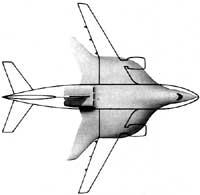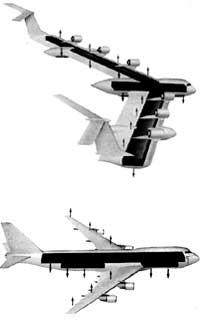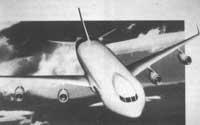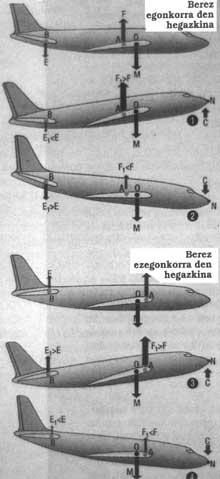Plane for a thousand passengers

The plane project for a thousand passengers is running and studying more than one aviator. Airbus Industries, Boeing, Lockheed, etc. are the ones dedicated to it, but the obstacles are not small. For this giant plane they have had to resort to “exotic” designs, since increasing the dimensions of the current planes does not solve the problem. It is intended to keep airport infrastructure unchanged.
Therefore, Boeing, for example, has equipped its model 777 with a system of fins collection, but this solution is not suitable, since on the one hand the plane is heavier and on the other, the plane that uses the wings of the passengers is not safe. As a result, the classic airplane design formula (central fuselage, two honeyed fins and tail stability planes) must be dispensed with.
The Airbus company has already held several sessions with the latest model called ASX 700. The model A is similar to 340, but in the central fuselage has two passenger floors and a different one. You cannot exceed 700 travelers per season.
Another solution could be the double wing plane or the biplane. Placing two blades on each side (one over the other), the giant plane would have the strength to stay in the air without the enormous width of the monoplane. However, the laws of Aerodynamics consider this solution interesting up to a speed of 300 km/h. From there, during the displacement the air resistance of the plane would be enormous and would consume too much with burns.
Exotic aircraft
New aerodynamic formulas are being studied for an aircraft that will transport a thousand passengers each time. The two wide classic attached to the central fuselage can be replaced by a delta with narrower fins attached to the entire length of the fuselage. The central fuselage itself would be integrated in thick fins and the occupants, both in the fuselage and in those thick fins, would sit. This delta plane would not have the stability plane that the usual ones carry in the tail.
Thanks to this system, space is available for large and heavy loads on the slopes and subsonic transport presents a great advantage in the form of delta, both in weight and fuel consumption and in production costs, whose aerodynamic performance is very good. In the classic plane, the central fuselage does not generate the necessary force to stay in the air (only the blades rise) and in delta form the superior force is found throughout the plane, so it can be lighter. In addition, in conventional aircraft, where the blades meet the fuselage, swirls grow and greater air resistance. The classic plane will burn more kerosene than the delta.
Delta shaped barriers

The biggest obstacle to delta aircraft is its natural instability. The differences between really stable and unstable aircraft are shown in the attached figure.
This instability benefits warplanes on the one hand, as the apparatus is lighter and more maneuverable. To compensate for instability, electric controls for flight (RAP) are used. However, in civil transport aircraft each passenger has no seats that can be thrown into the air due to power failure.
So far no unstable civilian aircraft have been manufactured, and if the Airbus model A 320 has electric controls for the flight is not unstable, but to make the plane on the pediment faster.
Another solution is to make a stable plane with double delta curvature, although currently the problems of unstable aircraft are solved with the so-called “general effective control” systems. The B-2 or F 117 bombers have this system, and a pilot used in the last Gulf War claimed it was as stable as the most stable aircraft, without losing at all the speed of the war in maneuverability. It does not seem, then, that there is an insurmountable obstacle to the construction of passenger planes in the form of delta.
Changes in airports
The exploitation of delta shaped planes would entail a series of changes in the current aircraft. Current aircraft entry and exit systems should be adapted. For “exotic” aircraft, for example, the telescopic steps currently used would not help thousands of passengers leave. Would it be necessary a group of underground stairs at the height of the plane to enter and leave so many people?
Another obstacle is the airport runway. In the same weight, the delta shape needs a speed of takeoff and landing superior to that of the conventional plane (and therefore a longer runway, 25% or 30% longer). The expensive solution is to extend the tracks, among other things because often there is no more space and when there are lands are expensive.
Existing projects
However, the plane integrated into the fuselage wings has advantages. Travelers, for example, would sit on two of every three wings and one of every three on the central fuselage. All travelers could also go on the slopes and many holes in the structure would allow entry and exit shortly.

However, the Airbus House has begun to talk about a plane shaped like stripes of blankets and we do not know if the project will materialize. At the moment the model A 340 will be the classic plane. A blanket for 800 or 900 passengers seems to be effective in the next generation.
In the late 1970s, DNA and Loockheeds proposed a series of formulas for giant aircraft. According to one, an eight-reactors aircraft would emit a total load of 1,600 tons (four times more than the Boeing 747 model). The load would be distributed throughout the width of the blades. Its delta wings and central fuselage are very small. This model, called Span Loader, would cover distances of up to 20,000 km and consume half of the classic plane per ton transported on transatlantic trips of about 4,000 kilometers.
In another study, NASA and Loocked compare two planes for the same cargo (544 tons in total and 272 available): the delta plane and the classic aircraft. The classic aircraft with six reactors of 26 tons of force would travel 2,000 kilometers at a speed of 0.8 males. The delta shape would double the distance to 0.87 males, but it would have six reactors of 32 tons of force.
In the Span Loader system one case would be to carry two out of three cargo fins and one out of three in the central fusel. It would reach a distance of 6,700 kilometers with a propulsion force of 100 tons (four reactors of 25 tons). Another case would be that of the boomerang plane. The distance covered would be 6,500 kilometers with a propulsion force of 144 tons (six reactors of 24 tons). This plane would land on an air mattress and not as usual on wheels.
However, it cannot be said that any of these projects are not going to be rolled on the bone planes and any delta of us.

Stable aircraft. The above force (F) thanks to aerodynamics is behind the center of gravity (M). When the plane is running, you have to balance it, that is, you have to compensate the moment when the force F that tilts the plane down the distance AO. For this, the tail planes have a small negative angle that allows them to be compensated with the realization of E.BO = F.AO. If an aerial whirlwind lifts the end of the plane (1), the C.NO moment occurs, but at the same time the ascending F force by the greater angle of the blade is greater and the rear E force is lower and the plane tends to be horizontal. The same happens if the swirl lowers the end (2). Then F is smaller and E is larger and the plane is still horizontal.
Unstable plane. The above force (F) thanks to aerodynamics, (M) is ahead of the center of gravity. The tail planes have a small positive angle. Reasoning as with stable aircraft, in any disturbance (caused by above (3) or below (4) at the end), the plane responds by amplifying the disturbance. The risk increases. But their advantage for war is that maneuvers are performed much faster. When the pilot points to a motion (similar to the previous disturbance), the plane responds more quickly. Unstable warplanes avoid obstacles to instability through mechanisms called “general effective control” and “electric control for flight”.
Buletina
Bidali zure helbide elektronikoa eta jaso asteroko buletina zure sarrera-ontzian











